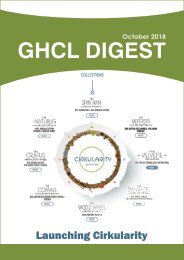You also want an ePaper? Increase the reach of your titles
YUMPU automatically turns print PDFs into web optimized ePapers that Google loves.
Article: Sustainability<br />
Green Buildings- Buildings with intention!<br />
This month from the sustainability desk, is an article to enlighten our readers on Green Buildings. Green<br />
buildings (also known as sustainable buildings) refer to both a structure and the application of<br />
processes that are environmentally responsible and resource-ef icient throughout a building's lifecycle:<br />
from planning to design, construction, operation, maintenance, renovation, and demolition. This<br />
requires close cooperation of the contractor, the architects, the engineers, and the client at all project<br />
stages.<br />
Buildings have extensive direct and indirect impact on the environment. During their construction,<br />
occupancy, renovation, repurposing, and demolition, buildings use energy, water, and raw materials,<br />
generate waste, and emit potentially harmful atmospheric emissions. This prompted for mitigating the<br />
impact of buildings on the natural environment through sustainable design. The Green Building practice<br />
expands and complements the classical building design concerns of economy, utility, durability, and<br />
comfort. The objective of green buildings is to reduce the overall impact of the built environment on<br />
human health and the natural environment by:<br />
Ef iciently using energy, water, and other resources<br />
Protecting occupant health and improving occupier's productivity<br />
Reducing waste, pollution and environmental degradation<br />
The push toward sustainable design increased in the 1990s with the creation of Building Research<br />
Establishment's Environmental Assessment Method (BREEAM), the irst green building rating system in<br />
the U.K. In 2000, the U.S. Green Building Council (USGBC) followed suit and developed and released<br />
criteria also aimed at improving the environmental performance of buildings through its Leadership in<br />
Energy and Environmental Design (LEED) rating system for new construction. Since that irst release,<br />
LEED has continued to grow in prominence and to include rating systems for existing buildings. Others<br />
also responded to the growing interest and demand sustainable designs including the Green Building<br />
Initiative (GBI), which was created to assist the National Association of Homebuilders (NAHB) in<br />
promoting its Green Building Guidelines for Residential Structures.<br />
There is now a proliferation of standards, rating, and certi ication programs in the marketplace to help<br />
guide, demonstrate, and document efforts to deliver sustainable, high-performance buildings. There are<br />
three primary Rating systems that currently exists in India: Green Rating for Integrated Habitat<br />
Assessment (GRIHA), Indian Green Building Council (IGBC), Bureau of Energy Ef iciency (BEE).<br />
The most criticized issue about constructing green buildings is the cost involved in construction or<br />
refurbishing. Modern technologies and systems tend to cost more money and may not be affordable<br />
every time. In reality most green buildings cost a premium of











